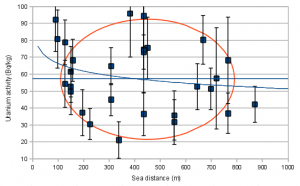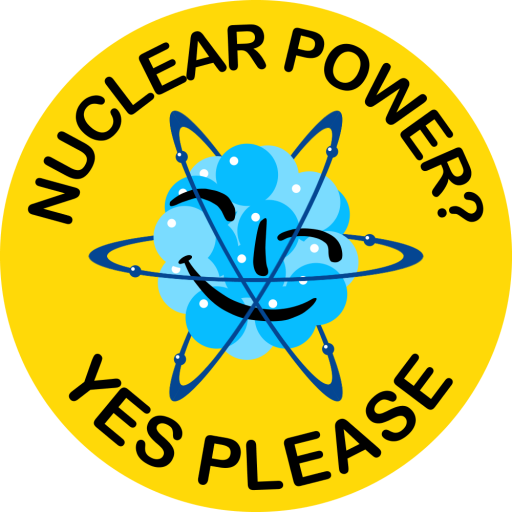Last updated on March 1, 2013
Professor Chris Busby is a man that has made himself somewhat of a career in being the golden boy of nuclear opponents, saying just the things they want/need to hear. There is only one problem with this: he doesn’t have a foot to stand on when it comes to his tall tales about the evils of nuclear power. Previously we have exposed his claims that the Chernobyl disaster supposedly caused an increase in breast cancer in Sweden. This turned out to be an unfounded conclusion, based on frivolous interpretation of data along with some outright cherry-picking and willful suppression of data that didn’t fit the claim.
In the case of The Tall Tale Of Ten Tons Uranium Gone Missing, Busby and his colleague Cecily Collingridge have issued a report where they claim that there has been a leak of enriched uranium from the British nuclear power plants at Hinkley Point in the order of about 10 000 kg. We analyzed the data which he used to make his claim, and took the same steps as he did, following his chain of reasoning from data to conclusion. The result is hardly flattering for the Busby and Collingridge, because the claims they make hinge on…
– Unsupported postulates
– Sparse and highly uncertain data
– Graph fitting done on this data, while ingoring uncertainties
– Low resolution geological surveys
– Misreading of said surveys
– Ignoring local variations in said surveys
– Ignoring missing indicators that must be present if their claim was true

- When you can fit any random graph of the data, in this case an elipsoid, something is not right.
The full analysis can be found in our forum. But I’ll just cut right to the chase and ask the obvious question: how would 10 tonnes(!) of uranium go missing without anyone noticing? And more important: why didn’t anything else go missing? The data that Busby uses to make his claim shows barely detectable levels of fission products, such as Cobalt-60 or Cesium-137. Considering that uranium is a lot less mobile than these products, if uranium goes missing but not the fission products, there cannot be a leak in the reactors because any such leak would have seen more fission products escape than uranium.
This leaves only one path as to how 10 tonnes of uranium could escape into the environment: when reactor fuel arrived fresh at the plants, someone took some fuel elements aside, stripped them of their cladding, ground them to dust and blew them out over the surrounding areas. Alternatively someone made a bonfire with them. And all of it happened without anyone noticing.
Since this is clearly not a reasonable explanation, we must conclude that Busby and Collingridge are wrong: there has not been a leak of 10 tonnes of uranium from Hinkley Point. The data they rely on does not support the claim, and it is only through their frivolous interpretation of the data, misreading some of it, and making unsupported assumptions that they arrive at the claim.
This begs a final question: claims have been made that there are numerous health problems around Hinkley Point, such as an increased incidence of childhood leukaemia. If there are no leaks from Hinkley Point, how would this be explained? Well… to find that answer, maybe you should go ask the one person making the claims: a certain professor Chris Busby.
/Michael Karnerfors and Mattias Lantz – members of Nuclear Power Yes Please

Warning: Declaration of Social_Walker_Comment::start_lvl(&$output, $depth, $args) should be compatible with Walker_Comment::start_lvl(&$output, $depth = 0, $args = Array) in /var/www/nuclearpoweryesplease.org/public_html/blog/wp-content/plugins/social/lib/social/walker/comment.php on line 18
Warning: Declaration of Social_Walker_Comment::end_lvl(&$output, $depth, $args) should be compatible with Walker_Comment::end_lvl(&$output, $depth = 0, $args = Array) in /var/www/nuclearpoweryesplease.org/public_html/blog/wp-content/plugins/social/lib/social/walker/comment.php on line 42
The salient point with this crowd, is to have an expose’.
It matters not if what is “exposed” is benign, or nonexistent.
At the U.S. Vermont Yankee plant, a special test rod was used once at startup to calibrate the flux monitors, and then permanently stored in their spent fuel area. 30 years later, local antinuke wags had an “expose'” that claimed “Fuel Missing From Vermont Yankee”, when the precise location of said rod could not be ascertained from public records.
Some weeks later, the proper record was unearthed, and the rod found – – exactly where it was supposed to be – – exactly where it had lain for some 30 years.
No retractions appeared, and it was “On to the next expose'” for this Chicken-Little-Jeremiad crowd of willfully fearful nincompoops. In another society, this behavior would be seen as a mental/medical pathology.
nincompoop… now there is a word I havn’t heard since my childhood Bugs Bunny cartoons. 🙂
Yes, what you are saying hold true to our experience of anti-nucelar fanatics: anything said about nuclear power that can be interpreted in a negative light is put forth, no matter the validity of facts or even a (lack of) resonable conherent chain of thought from fact to conclusion.
The prime example being Harrisburg/Three Mile Island: a complete success-story when it comes to keeping the public safe, even in the face or a complete breakdown of the Man-Machine Interaction… yet “everyone” heralds it as an example of a supposed danger.
And then – just as you say – they just don’t mention it and quickly move on to new poitns to attack. Hush down and ignoring any response you have made.
We have found that the best way to deal with this is to counter-attack, in areas they have never touched before, or coming with new angles. Like for instance the fact that nuclear power easilly can be concidered sustainable development while some renewables – like wind and solar – cannot meet the criteria unless also backed up by a reserve.
http://nuclearpoweryesplease.org/blog/2009/02/14/did-you-think-renewable-power-is-sustainable-think-again/
Tat usally throws them off the track and confuses them. But then – again – they give you the silent wall treatment.
A valid point was raised by Peter Lanyon on the One World Column blog (http://oneworldcolumn.blogspot.com/2011/02/nuclear-industrys-desperate-last-stand.html), that we have no information about the data from the top 26 cm of the soil. This is correct, and it would be very nice to see those data (details about the British regulations on how and why these data have not been released are not known to us).
But it does not in any way change our view of the Busby-Collingridge study, there is no justification for any of their speculations based on the available data. Except for misleading people into thinking like them, of course.
Correction, the comment by Peter Lanyon is in the commentary field of the One World Column blog entry, the blog itself is run by Marguerite Finn.
If I may, I have two niggles with the (very nice I might add) arse kicking dispenced at the so called Prof Busby et al.
Co-60 is not a fission fragment, it is an activation product…but this is a minor point.
What I think is quite agrevating is the fact that a proffesor of life sciences don’t know how to evaluate and analyze measurement data from the field. And he has a background in spectroscopy for heavens sake! This man is either seriously incompetent or an outright liar, which should be made clear to anyone who listens to him… Or am I wrong?
This man is either seriously incompetent or an outright liar, which should be made clear to anyone who listens to him
Oh you’d be surprised how far people are willing to go to turn a blind eye to inconsistencies in a statement as long as the statement is what they want to hear.
Thanks for the correction regarding Co-60, you are right that it comes from activation of natural Cobolt used in alloys, my mistake.
Regarding Busby’s handling of data, there are several studies where he makes bold claims, displaying confidence levels or p-values, but almost always without showing any uncertainties on the raw data.
Anybody is free to make their own guess of whether he is lying or if he is just incompetent. In any case the conclusion is the same: What he says does not deserve to be taken seriously.
He could be right on some of his earlier studies (we have not checked all of his work, he is very productive), but caution is advised for anybody who wants to refer to him in order to justify their cause with a scientific backup.
Oh, Cecily Collingridge will continue to work with professor Busby as she is an anti nuclear activist with strong ties to the “No to Hinkley” organisation/movement. She probably believes that publishing articles with Busby will boost her own name, probably might in her circles but not anywhere else…
Check out http://www.nuclearjustice.org guys and respond.
love
Chris
Give us one good reason why.
We are already wasting way too much time debunking your junk. And that site apparently has next to no traffic at all which means all we’d do is bark at you while you ignore us… no outreach and noone to benefit from our effort.
Tell us… is it it really worth it just to have aging anti-nukes fawning all over you Chris?
Respond to what? More junk obviously…
EDITED: Sorry Brian but I’m not gonna allow that. I take such matters very seriously. Unless you have professional expertiese in that particular subject, you cannot label someone like that. Also under Swedish law you are dangerously close to overstepping the line and that is one of the rules of this blog.
/Michael
Be careful Brian… flippant and harsh is one thing… but there are limits.
/Michael